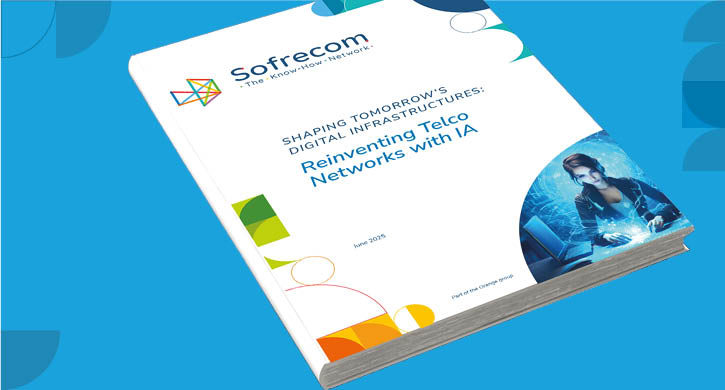
Under the influence of AI, telecom networks are becoming autonomous, capable of self-repair, adapting to demand, and optimizing their performance. AI, Big Data, and Machine Learning enable intelligent and predictive management, transforming networks into cognitive and self-adaptive infrastructures.
Mohamed CHAIB

From utopia to reality
The idea of an autonomous telecom network once seemed utopian, but today it’s becoming tangible thanks to advances in Big Data, Machine Learning, and AI. These technologies enable networks to learn and optimize themselves independently, transforming telecom operations. A 2021 Sofrecom white paper already highlighted AI’s potential to improve service quality
and raised questions about predicting network issues. Self-configuration and self-optimization tools, like NG SON for 5G, are beginning to emerge. However, this evolution presents challenges, including the need for massive data, investments, and new skills for teams. The role of network engineers is shifting toward «Network Data Scientist.» Questions remain about the limits of this autonomy and the future of telecoms.
Autonomous & intelligent networks powered by AI
Once manually managed, telecom networks required constant human intervention to adjust capacity and fix failures. With automation and AI growth, infrastructure has become smarter, capable of dynamically optimizing resources and anticipating anomalies. Today, networks are evolving toward full autonomy, self-healing and adapting in real time to user needs. This transformation, accelerated by AI, paves the way for ultra-high-performance, more reliable, and efficient connectivity.
Exploring AI Applications in Telcos
Let’s now discover the main areas where AI is revolutionizing networks, along with concrete use cases that enhance performance, security, and operational efficiency.
• Proactive monitoring and predictive maintenance with AI
Proactive monitoring and predictive maintenance are essential for managing complex infrastructures like 5G networks. Enabled by AI, these strategies offer significant benefits in reliability, cost reduction, and operational efficiency.
• Proactive monitoring with AI
AI enables continuous real-time monitoring of network equipment. By analyzing large volumes of data from sensors and monitoring systems, AI can detect anomalies or early signs of failure before they become major issues. This allows immediate action, often before users notice any service degradation.One major advantage is reducing network downtime. Traditionally, problems are detected after a major failure or when users experience issues. With AI, failures can be anticipated and fixed beforehand, improving both network performance and user experience.
• Maintenance maintenance: reducing failures and costs
Complementing proactive monitoring, predictive maintenance uses machine learning models and big data to forecast equipment health and identify failure risks before they occur. AI analyzes
historical data trends, detects invisible patterns, and predicts when equipment might fail. This enables targeted maintenance interventions instead of generic repairs based on fixed
schedules. It reduces maintenance costs, avoids unnecessary interventions, and optimizes
resources by only deploying technicians when needed.
Real-world example: Using AI algorithms to monitor a 5G network
An operator reduced critical failures by 30% and improved network stability.
Impact on jobs: Technicians and engineers shift from reactive to proactive roles, focusing on data analysis and continuous optimization. AI algorithms help reduce critical failures, enhance network stability, and lower costs and service interruptions.
Toward an intelligent, autonomous, and self-optimizing telecom network via AI & advanced orchestration
Network evolution accelerates with the integration of Service Management & Orchestration (SMO), a central hub unifying network management, automation, and performance optimization. Through interactions with key technologies like RAN Intelligent Controller (RIC), Self-Organizing Network (SON), Cloud RAN (C-RAN), Open RAN (O-RAN), and OSS 2.0, it drives a radical transformation toward intelligent, flexible, and fully autonomous networks.
The RIC, divided into RT-RIC (Real-Time) and Non-RT RIC (Non-Real-Time), plays a key role in continuously optimizing network performance via xApps and rApps. rApps (on Non-RT RIC) analyze long-term trends to anticipate congestion and adapt spectrum management strategies.
The SON (Self-Organizing Network) is evolving toward deeper automation with SON 2.0, which uses AI to dynamically adjust coverage, frequencies, and parameters without human intervention. Its integration with RIC and SMO ensures seamless orchestration of legacy, O-RAN, and C-RAN infrastructures, supporting a gradual transition to virtualized, open architectures.
Case studies: AI & Orchestration
• Real-time 5G network optimization
An operator deployed RT-RIC with xApps to optimize resource allocation in a dense urbanbarea, reducing congestion by 35%, lowering latency by 20%, and improving streaming and video call quality.
• Predictive maintenance
By integrating SON 2.0 with rApps, another operator predicted hardware failures, reducing critical failures by 50% and lowering operational costs.
• Interference management in Open RAN
Using xApps and rApps within O-RAN and C-RAN, a company reduced radio interference by 30%, enhancing signal stability and coverage.
A new, smarter and more efficient next-generation network
This integrated approach enables proactive, automated, and optimized network management, where each component interacts seamlessly. Thanks to AI, machine learning, and automation, operators can deliver ultra-high-performance connectivity while reducing operational costs and energy consumption. The future of telecoms lies in these intelligent, self-adapting networks.
The digital twin: Toward smart & predictive network management
The Digital Twin creates a dynamic virtual replica of physical infrastructure, not just a static copy but an evolving, interactive model fed in real time by network data. It allows operators to visualize, analyze, and predict network states before issues occur.
Using AI, ML, and predictive analytics, the Digital Twin anticipates failures, detects anomalies, and suggests real-time adjustments to optimize resource management. For example, it can forecast traffic overloads on a 5G cell and recommend dynamic frequency reallocations before user experience degrades.
This approach reduces risks associated with network changes, speeds up operational decisions, and enhances QoS. With the Digital Twin, operators shift from reactive management to proactive, intelligent operation, paving the way for autonomous, ultra-optimized networks.
Case studies : Digital twin platform
A platform for creating multi-domain Digital Twins (industry, agriculture, healthcare, telecoms) integrates heterogeneous data for an accurate virtual representation. It models objects and interactions via structured and semantic graphs, updating continuously through periodic synchronization with real-world data. This supports scalable, interconnected management and collaborative process optimization.
Digital twin for optical network ‘s illustrative example
Optical network Digital Twin improves visualization, detects failures in real time, simulates optimal resolutions, and facilitates operator workflows. Future developments include failure prediction and automatic corrective actions, enabling faster recovery and better service restoration.
Conclusion
AI is more than an optimization tool; it is fundamentally reshaping the future of telecom networks. Today, it enables intelligent resource management, predictive maintenance, and advanced automation. But tomorrow?
Imagine networks that self-adapt in real time, predicting congestion before it happens, dynamically allocating frequencies based on user needs, and deploying autonomous flying antennas during extreme overloads.
Ultra-powerful AI assistants could orchestrate entire infrastructures, interacting with Digital Twins to test scenarios before deployment—all without human intervention, optimized proactively.
Looking ahead to 6G, concepts like self-learning cognitive networks, where rApps and xApps collaborate with Digital Twins to predict and prevent cyberattacks, are emerging. Researchers are even exploring quantum AI for unmatched performance and security.
AI is no longer just transforming telecom networks; it is becoming their architect. Are we ready for fully autonomous, intelligent networks capable of instantaneously responding to the needs of billions of connected objects? One thing is certain—the revolution has only just begun…






